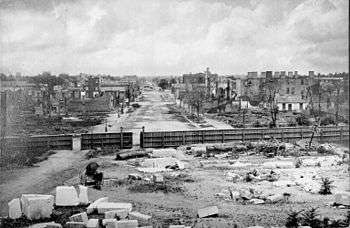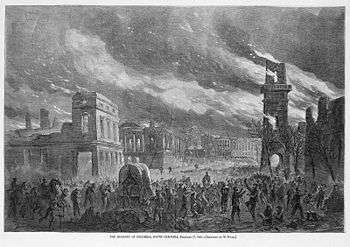Columbia, South Carolina in the American Civil War

The Southern United States city of Columbia, South Carolina, was an important political and supply center for the Confederate States Army during the American Civil War. Much of the town was destroyed during occupation by Union forces under Major General William T. Sherman during the Carolinas Campaign in the last months of the war, although who caused the destructive fire is controversial.[1]
Early Civil War history
Columbia became chartered as a city in 1786 and soon grew at a rapid pace, and throughout the 1850s and 1860s it was the largest inland city in the Carolinas.[2] Railroad transportation served as a significant cause of population expansion in Columbia during this time. Rail lines that reached the city in the 1840s were first and foremost interested in transporting cotton bales, not passengers. Cotton was the lifeblood of the Columbia community, as before the Civil War, directly or indirectly, virtually all of the city's commercial and economic activity was related to cotton.[3]
Columbia's First Baptist Church hosted the South Carolina Secession Convention on December 17, 1860, with delegates selected a month earlier at Secession Hill. The delegates drafted a resolution in favor of secession without dissent, 159-0, creating the short-lived Republic of South Carolina.[4] Columbia's location made it an ideal spot for other conventions and meetings within the Confederacy. During the ensuing Civil War, bankers, railroad executives, teachers, and theologians from several states met in the city from time to time to discuss certain matters.
Castle Sorghum was a Confederate prisoner-of-war camp established in 1862 in Columbia. It consisted of a 5-acre (20,000 m2) tract of open field, without walls, fences, buildings or any other facilities. A "deadline" was established by laying wood planks 10 feet (3.0 m) inside the camp's boundaries. The rations consisted of cornmeal and sorghum molasses as the main staple in the diet; thus the camp became known as "Camp Sorghum." Due to the lack of any security features, escapes were common. Conditions were terrible, with little food, clothing or medicine, and disease claimed a number of lives among both the prisoners and their guards.[5]
The burning of Columbia
Following the Battle of Rivers' Bridge on February 3, 1865, the Confederate division of Maj. Gen. Lafayette McLaws attempted to prevent the crossing of the Salkehatchie River by the right wing of Maj. Gen. William T. Sherman's Union army. The Union division under Maj. Gen. Francis P. Blair (Howard's army) crossed the river and assaulted McLaws's flank. McLaws withdrew to Branchville, causing only one day's delay in the Union advance.[6]

On February 17, 1865, Columbia surrendered to Sherman, and Wade Hampton's Confederate cavalry retreated from the city. Union forces were overwhelmed by throngs of liberated Federal prisoners and emancipated slaves. Many soldiers took advantage of ample supplies of liquor in the city and began to drink. Fires began in the city, and high winds spread the flames across a wide area. Most of the central city was destroyed, and municipal fire companies found it difficult to operate in conjunction with the invading army, many of whom were also fighting the fire. The burning of Columbia has engendered controversy ever since, with some claiming the fires were accidental, a deliberate act of vengeance, or perhaps set by retreating Confederate soldiers who lit cotton bales while leaving town. On that same day, the Confederates evacuated Charleston. On February 18, Sherman's forces destroyed virtually anything of military value in Columbia, including railroad depots, warehouses, arsenals, and machine shops.[7]
In his book The Burning of Columbia, S.C., Dr. Daniel Trezevant holds Governor Magrath and General Wade Hampton partly accountable for the burning. While others wanted to send out a delegation to surrender the city far from a safe distance, the Governor vetoed the idea, while General Hampton vowed to defend the city "from house to house."[8]
Among the buildings burned were the old South Carolina State House and the interior of the incomplete new State House. The old State House was constructed between 1786 and 1790. James Hoban, a young Irishman who emigrated to Charleston shortly after the Revolution, was the architect. Upon the recommendation of Henry Laurens, President Washington engaged him to design the executive mansion in Washington. Old pictures of the two buildings show architectural similarities.[9]

Legend has it that Columbia's First Baptist Church narrowly missed being torched by Sherman's troops. As the story goes, the soldiers marched to the church and asked the groundskeeper if he could direct them to the location of the church where the declaration of secession was signed. The loyal groundskeeper directed the men to another church, a Methodist church located nearby; thus, the historic landmark avoided being destroyed by Union soldiers.[10]
Among the buildings destroyed was "Millwood," a large mansion owned by Confederate general Wade Hampton. His late father's home, the Hampton-Preston House in downtown Columbia, was spared as it was being used as the headquarters for Union Maj. Gen. John A. Logan.[11]
Controversy surrounding the burning of the city started soon after the war ended. General Sherman blamed the high winds and retreating Confederate soldiers for firing bales of cotton, which had been stacked in the streets. Sherman denied ordering the burning, though he did order militarily significant structures, such as the Confederate Printing Plant, destroyed.
Firsthand accounts by local residents, Union soldiers, and a newspaper reporter offer a tale of revenge by Union troops for Columbia's and South Carolina's pivotal role in leading Southern states to secede from the Union, whereas other accounts (as documented in, for example, James W. Loewen's Lies Across America: What Our Historic Sites Get Wrong) portray it as mostly the fault of the Confederacy.[12]
During Reconstruction, Columbia became the focus of considerable attention. Reporters, journalists, travelers, and tourists flocked to South Carolina's capital city to witness a Southern state legislature whose members included ex-slaves. The city also made somewhat of a rebound following the devastating fire of 1865; a mild construction boom took place within the first few years of Reconstruction, and repair of railroad tracks in outlying areas created jobs for area citizens.
Notable Civil War personalities from Columbia
- Maxcy Gregg — Confederate brigadier general mortally wounded at the Battle of Fredericksburg
- Alexander Cheves Haskell — Colonel of the 1st South Carolina Cavalry, led a Confederate brigade late in the war
William Augustus Reckling (1850-1913) was a noted SC Photographer operating in Columbia 1870-1910 at times with his 2 sons as "Reckling & Sons Photographers" on Senate St now part of the USC campus. The latter has a collection of Reckling's photos of notable South Carolinians of the era as well as a series of sterographs of Columbia. [13]
Civil War tourism
The Confederate Relic Room and Military Museum, part of the S.C. Budget and Control Board, showcases an artifact collection from the Colonial period to the space age. The museum houses a collection of artifacts from the South Carolina Confederate period. The impacts from Sherman's cannonballs to the granite exterior of the State House were never repaired and are marked by six bronze stars.
Today, tourists can follow the path General Sherman's army took to enter the city and see structures or remnants of structures that survived the fire. A Civil War walking tour is available.[14]
References
- Eicher, David J., The Longest Night: A Military History of the Civil War, Simon & Schuster, 2001, ISBN 0-684-84944-5.
- Burton, Elijah P. Diary of E.P. Burton, Surgeon, Seventh Regiment Illinois, Third Brigade, Second Division, Sixteenth Army Corps, II, 63. Des Moines, 1939
- Campbell, Jacqueline G. "'The Most Diabolical Act of all The Barbarous War': Soldiers, Civilians, and the Burning of Columbia, February, 1865." American Nineteenth Century History, Vol. 3, No. 3, Fall 2002
- Fellman, Michael. Citizen Sherman: A Life Of William Tecumseh Sherman. New York, 1995.
- Gibbes, James Guignard. Who Burnt Columbia? Newberry, SC, 1902
- Howard, Oliver Otis. Autobiography of Oliver Otis Howard, Major General, United States Army. New York, 1907
- Lucas, Marion Brunson. Sherman and the Burning of Columbia. College Station: Texas A&M University Press, 1976
- McCarter, James. "The Burning of Columbia, Again." Harper's Magazine 33, October, 1866
- Magrath, Andrew. "From The Governor of the State, to the People of South Carolina." Legislative System, Messages, 1860-1865. South Carolina Archives, Columbia, South Carolina.
- Miers, Earl Schenck. The General Who Marched To Hell. New York,1951.
- Miers, Earl Schenck. When The World Ended: The Diary of Emma LeConte. New York, 1957
- Simms, William G. Sack and Destruction of the City of Columbia S.C. Columbia: Power Press of Daily Phoenix, 1865.
- Teal, Harvey S. "Partners with the Sun, South Carolina Photographers, 1840-1940" University of South Carolina Press (2001).
- Snowdon, Yates. Marching With Sherman: A Review of the Letters and Campaign Diaries of Henry Hitchcock. Columbia, 1929
- Whilden, Mary S. Recollections of the War, 1861-1865, 1887. Reprint: Columbia, 1911.
Notes
- ↑ Gibbes, Who Burnt Columbia?
- ↑ U.S. Census 1860
- ↑ Lucas, Sherman and the Burning of Columbia.
- ↑ Magrath, "From The Governor of the State, to the People of South Carolina."
- ↑ Camp Sorghum website
- ↑ National Park Service battle description
- ↑ Campbell, "'The Most Diabolical Act of all The Barbarous War': Soldiers, Civilians, and the Burning of Columbia, February, 1865."
- ↑ Trezevant, D. H. (1866). The burning of Columbia, S.C:.A review of Northern assertions and Southern facts. Columbia, S.C.: South Carolininan Power Press.
- ↑ Statehouse history
- ↑ Touring Columbia
- ↑ Columbia nun saves the Hampton House
- ↑ Harper's Magazine, October 1866.
- ↑ "Partners With the Sun, South Carolina Photographers, 1840-1940." Harvey S. Teal, University of South Carolina Press (2001).
- ↑ Columbia tourism
